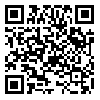Volume 9, Issue 4 (1-2023)
Human Information Interaction 2023, 9(4): 1-12 |
Back to browse issues page
Download citation:
BibTeX | RIS | EndNote | Medlars | ProCite | Reference Manager | RefWorks
Send citation to:



BibTeX | RIS | EndNote | Medlars | ProCite | Reference Manager | RefWorks
Send citation to:
Abdullah A M, Mokhtari S, navaee F. Examining the fields of plagiarism in students and providing preventive solutions. Human Information Interaction 2023; 9 (4)
URL: http://hii.khu.ac.ir/article-1-3092-en.html
URL: http://hii.khu.ac.ir/article-1-3092-en.html
Associate Professor, Department of Islamic Education, Allameh Tabatabai University, Tehran, Iran
Abstract: (6981 Views)
Introduction: plagiarism is one of the new phenomena in the academic environment in Iran, which includes different dimensions and types. So, its recognition and rooting are the problems of this research. Therefore, the main goal of the current research is to investigate the context and institutional and individual factors affecting the formation of plagiarism in Iran and provide policy solutions by decision-makers.
Methods: The current research method is descriptive qualitative. The statistical population of the research includes 15 university experts who were selected by judgment and snowball method. The data collection tool is a researcher-made questionnaire, which was completed during three stages (in a round-trip way) of indexing using the Delphi technique, and the validation of the conceptual model of the research was done using experts' opinions.
Results: The findings of the research showed that the factors affecting the occurrence of plagiarism in universities in Iran include two categories of individual and systemic components and 21 indicators related to these components. Individual factors related to the inherent personality characteristics of students such as lack of ideas, inability to manage time, lack of guilt, lack of some skills, and also some deficiencies in professors such as insufficient knowledge, lack of motivation among students, etc. Systemic or institutional factors are mostly due to incomplete and insufficient laws of universities, inappropriate training of these centers, and lack of attention to plagiarism and plagiarism.
Conclusion: In the end, based on both individual and systemic effective components, practical solutions have been presented to deal with plagiarism in universities.
Methods: The current research method is descriptive qualitative. The statistical population of the research includes 15 university experts who were selected by judgment and snowball method. The data collection tool is a researcher-made questionnaire, which was completed during three stages (in a round-trip way) of indexing using the Delphi technique, and the validation of the conceptual model of the research was done using experts' opinions.
Results: The findings of the research showed that the factors affecting the occurrence of plagiarism in universities in Iran include two categories of individual and systemic components and 21 indicators related to these components. Individual factors related to the inherent personality characteristics of students such as lack of ideas, inability to manage time, lack of guilt, lack of some skills, and also some deficiencies in professors such as insufficient knowledge, lack of motivation among students, etc. Systemic or institutional factors are mostly due to incomplete and insufficient laws of universities, inappropriate training of these centers, and lack of attention to plagiarism and plagiarism.
Conclusion: In the end, based on both individual and systemic effective components, practical solutions have been presented to deal with plagiarism in universities.
Type of Study: Applicable |
Subject:
Special
References
1. Aghajani, R., Keyvan Ara, M., Cheshmeh Sohrabi, M., and Papi, A. (2012). Pathological analysis of cheating and scientific theft: based on a qualitative research. Iranian Journal of Education in Medical sciences/ Special Issue on of Educational Development and health promotion, 1063-1073.
2. Amiri, M. & Khamsyan, A. (2012). Lack of scientific honesty a threat to the dignity of higher education system: A review of personal and contextual factors.
3. Darouian, S. & Faghihi, M. (2012). The Study of Motives and Causes of Scientific Theft. Quarterly of the Mission of Public Management, 1, 137- 154.
4. de Lima, J. Á., Sousa, Á., Medeiros, A., Misturada, B., & Novo, C. (2021).Understanding undergraduate plagiarism in the context of students' academic experience. Journal of Academic Ethics, 1-22. [DOI:10.1007/s10805-021-09396-3]
5. Dyrbye, L. N., Thomas, M. R., Huntington, J. L., Lawson, K. L., Novotny, P. J., Slaon, J. A., et al. (2006). Personal life events and medical student burnout: A multicenter study. Academic Medicine, 81, 374−384. [DOI:10.1097/00001888-200604000-00010] [PMID]
6. Faucher, D., & Caves, S. (2009). Academic dishonesty: Innovative cheating techniques and the detection and prevention of them. Teaching and Learning in Nursing, 4(2), 37-41. [DOI:10.1016/j.teln.2008.09.003]
7. Gulli, C., Kohler, N., & Patriquin, M. (2007). The great university cheating scandal. Maclean's, 120, 32−36.
8. Johanson, L. S. (2010). Encouraging academic honesty: A nursing imperative. Journal of Christian Nursing, 27(3), 267-271. Amuticampus investigation. Research in Higher Education, 38(3), 379-96. San Diego. [DOI:10.1097/CNJ.0b013e3181dd7989] [PMID]
9. Pournaghi, R. Khosravi, M (2022). The Relationship between Knowledge, Ethical Perceptions and Students Plagiarism, Journal of Ethics in Scince and Technology, 17(1), 92-95. magiran.com/p2447356
10. Selwyn, N. (November 1, 2008). A safe haven for misbehaving?: An investigation of online misbehavior among university students. Social Science Computer Review, 26(4), 446-465. [DOI:10.1177/0894439307313515]
11. Soheili, F. Hamidi,A. Khasseh ,A.A (2022). The effect of the perception of plagiarism, plagiarism attitudes, values personality and the right-concept study on plagiarism among Ph.D. Students of Bu-Ali Sina University, Journal of Academic Librarianship and Information Research, 55(2), 1-20.
12. Tremayne, K. & G. J. Curtis. 2021. Attitudes and understanding are only part of the story: self-control,
13. age and self-imposed pressure predict plagiarism over and above perceptions of seriousness and
14. understanding. Assessment & Evaluation in Higher Education 46 (2): 208-219
15. Webster. (2000). Webster Dictionary, 43.
16. Ziaei, S. Zamani Behabadi,N (2016). Plagiarism of view of postgraduate students of Payam Noor University of Mashhad, Knowledge and Information Management, 3(1), 87-96. magiran.com/p1748990
Send email to the article author
| Rights and permissions | |
 | This work is licensed under a Creative Commons Attribution-NonCommercial 4.0 International License. |






